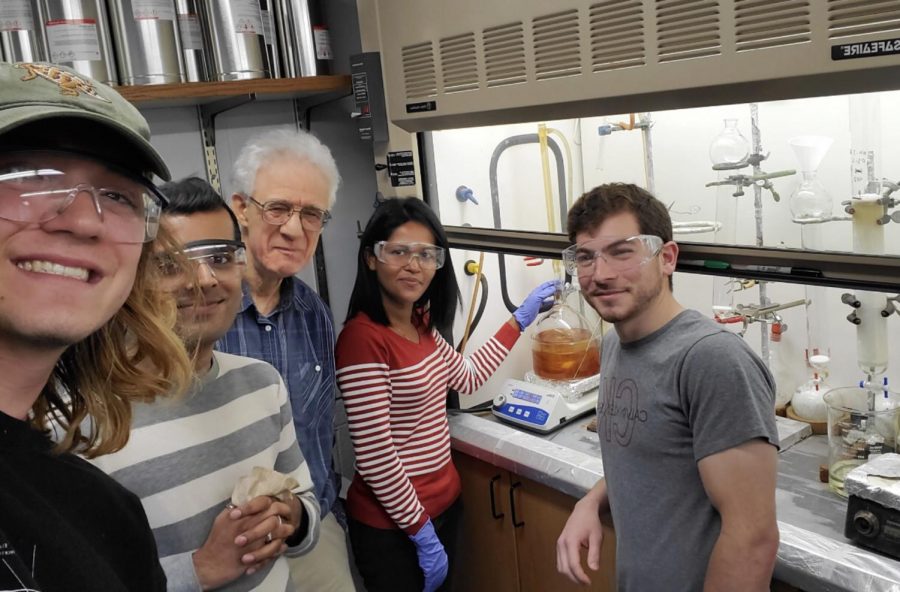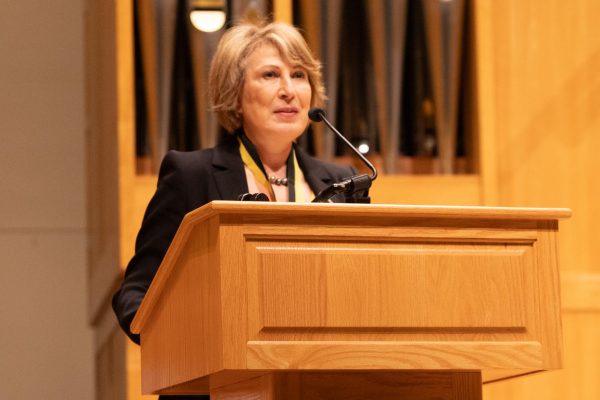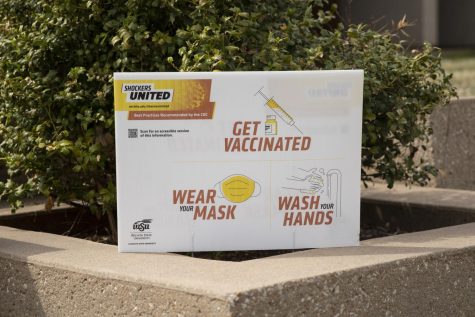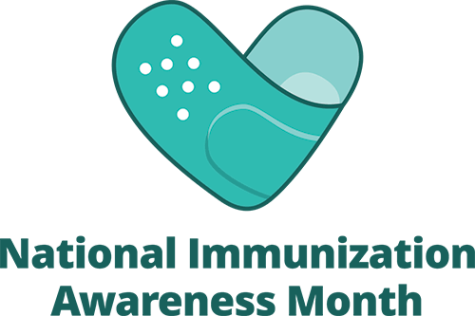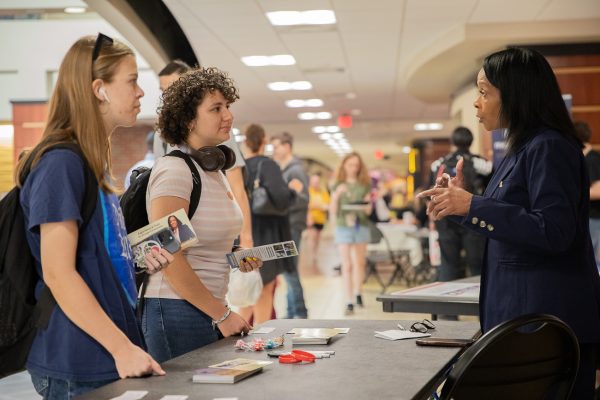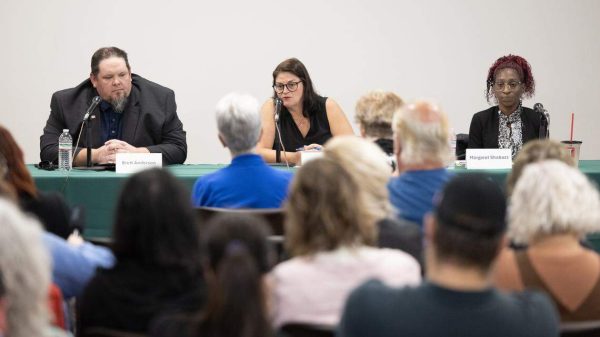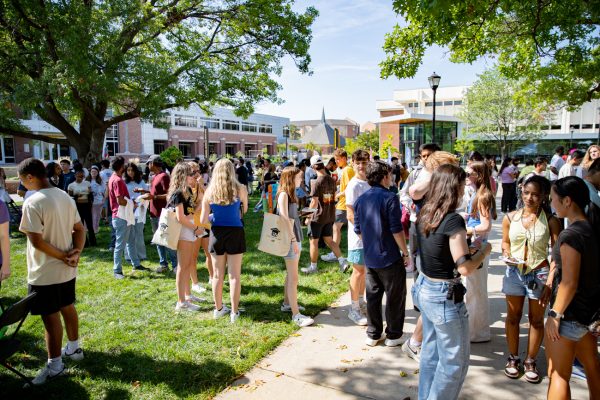‘The impact can be huge’: WSU professor part of team to discover compound that kills a coronavirus
William Groutas, a bioorganic and medicinal chemistry professor at Wichita State (center) and research assistants pose in Groutas’s research laboratory at WSU.
William Groutas, the Endowment Association’s Distinguished Professor of Bioorganic and Medicinal Chemistry at Wichita State, is one of four researchers who discovered a compound that can stop a strain of coronavirus from killing its hosts.
The study was done on cats using a feline coronavirus. Animal studies are a big part of the antiviral development process because they show what’s potentially lifesaving and what’s toxic.
Groutas worked alongside Yungeong Kim and Dr. Kyeong-Ok “KC” Chang, virologists at Kansas State College of Veterinary Medicine, and Stanley Perlman, a professor of microbiology and immunology and pediatrics at the University of Iowa medical school.
The team’s research didn’t begin in response to COVID-19. Groutas has been studying and working on noroviruses in collaboration with the group at KSU Vet school for 10 years. He said their work has led to multiple patents.
As for the coronavirus breakthrough, the timing was coincidental. It happened to come in the middle of the latest epidemic coronavirus outbreak, COVID-19.
Groutas said he and the team did a couple of clinical studies with this compound and found that it was very effective in helping cats that were close to dying.
“In the course of our investigations with noroviruses, we serendipitously discovered that one of the compounds inhibits feline infectious peritonitis virus (FIPV), a coronavirus that afflicts cats and has 100% fatality rate,” Groutas said.
“In clinical trials with cats afflicted with FIPV, the compound cures the cats,” he said.
The compound, designated GC376, has been licensed to pet pharmaceutical company Anivive Lifesciences and is now in clinical development for the treatment of FIPV.
Background of a virus
To understand the implications of this discovery, there are a few things that the layperson needs to understand about coronaviruses and the quest to create antiviral inhibitors that will produce pharmaceutical treatments for this disease and others like it.
Coronaviruses are a large group of viruses that cause diseases in animals and humans. They often circulate among camels, cats, and bats, and can sometimes evolve and infect people.
According to The New York Times, at least six types of coronaviruses are known to infect humans besides the novel coronavirus (COVID-19, also referred to as 2019-nCoV and SARS-CoV-2), which is responsible for the current pandemic that emerged in the Chinese city of Wuhan in 2019.
COVID-19 is a close relative to the severe acute respiratory syndrome (SARS) virus that caused an outbreak in 2003 (SARS-CoV-1), as well as the Middle-East respiratory disease virus (MERS-CoV) that emerged in 2012.
According to The New York Times, the virus infects a cell, and once inside, the coronavirus releases a snippet of genetic material called RNA. The infected cell reads the RNA and begins making proteins that will keep the immune system at bay and help assemble new copies of the virus. New copies of the virus are assembled and carried to the outer edges of the cell. The infection advances as the cell begins to churn out proteins that form more copies of the coronavirus.
Each infected cell can release millions of copies of the virus before the cell finally dies. The viruses may infect nearby cells. If it escapes the lungs, it can end up in droplets, which are what spread the illness from person to person.
If the immune system reacts and starts attacking lung cells, the lungs fill with fluid and dying cells. That’s what makes it difficult to breathe for people who are infected. In the worst of cases, acute respiratory distress syndrome occurs, which can be fatal.
All of these coronaviruses share a similar protein-cutting enzyme called the “main protease,” Groutas said.
“In order for the virus to survive and replicate, it uses a number of enzymes to do that,” he said. “One enzyme that we are focused on ourselves is what we call a protease enzyme, and without this enzyme, the virus is dead. If you can kill the enzyme, inhibit it, then the virus cannot replicate.”
Groutas said there are many drugs on the market for HIV for example, that are called protease inhibitors.
The focus is on figuring out how to inhibit that enzyme and therefore kill the virus, he said.
“Concomitantly, our investigations led to the discovery of another class of compounds that are effective against Middle East Respiratory Syndrome caused by MERS coronavirus in a mouse model of infection,” he said. “We’re talking about small molecule therapeutics.
“What we have shown is some of the compounds that we have potently inhibited the enzyme when the enzyme is isolated by itself, and so this is what we mean by doing the test in a test tube,” he said. “Then, the next stage once you identify compounds that inhibit the enzyme is to try to demonstrate that the compounds have efficacy — that it was effective — in a mouse model of the disease, and that’s what we are in the process of doing right now.”
These compounds, as well as related norovirus compounds, have been recently licensed to Cocrystal Pharma for further development for use against MERS-CoV, Groutas said.
“They will be taking over parts of what we’re doing right now and pushing these through at lightning speed,” he said.
He said this work also led to another discovery.
“We have also identified compounds that inhibit the SARS-CoV2 protease, an enzyme that is essential for viral replication. We are guardedly optimistic that these compounds may be effective against SARS-CoV2 in animal studies,” he said.
That would be the same virus that has spurred on the global pandemic.
Groutas said this is an encouraging finding considering the state of the world right now. Many researchers across the globe are looking at these coronaviruses for insight now. Their work will impact the development of antiviral treatments.
No vaccine or drugs are currently available to treat coronaviruses, Groutas said.
What comes next?
Hundreds of studies are happening now with compounds and enzymes from SARS, MERS, and COVID-19. But generally speaking, the effort to end coronaviruses has seen little advancement over the years.
Now, there are scores of scientists working towards the goal of creating a drug that would stop these viruses from replicating. But that doesn’t lessen the load for Groutas. If anything, it ups the ante, he said.
“We’re not collaborating with anybody outside the United States,” he said.
“It’s a race. Our race is here in this country.”
Collaborations are built from the ground up, Groutas said. In this circumstance, it just so happens that the collaboration took place here in Kansas and in Iowa.
“We’re engaged in basic science, in drug discovery and our primary focus on the problem itself,” Groutas said. “It is a way for us to make a meaningful contribution to solving the problem.
“We’re exploring other classes of compounds that can also be effective against COVID-19.”
The process can be a laborious one.
“My work is never done,” Groutas said.
He said the team of researchers will continue their efforts to discover different types of inhibitors, but he’s delighted with what they have accomplished so far and what it could mean for the world.
“The impact can be huge,” he said.
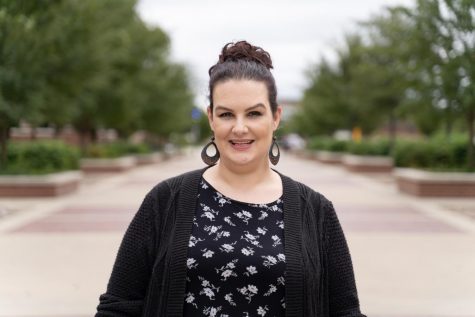
Audrey Korte was a reporter and the opinion editor for The Sunflower. She hosted The Sunflower News Podcast.



